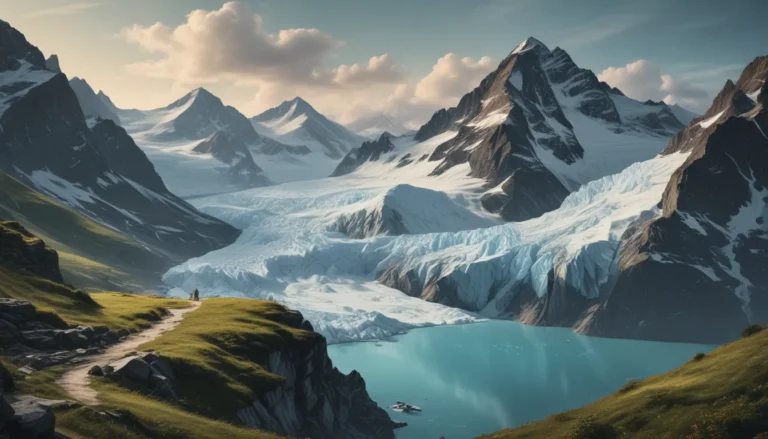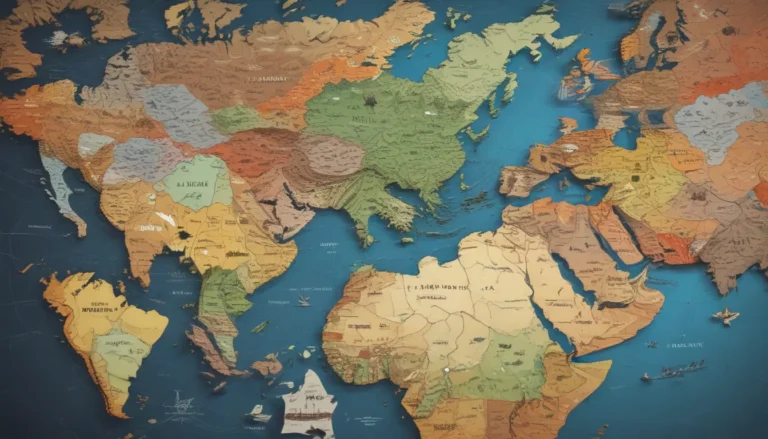A Note About Images: The images used in our articles are for illustration purposes only and may not exactly match the content. They are meant to engage readers, but the text should be relied upon for accurate information.
Welcome to the incredible journey through time as we unveil 10 surprising facts about the Geologic Time Scale. This fascinating tool offers a glimpse into the long and intricate history of our planet, covering billions of years of geological and biological evolution. Join us as we delve into the complexities of Earth’s past, uncovering remarkable connections and insights that will deepen your understanding of our planet’s history.
Unraveling Earth’s History Through the Geologic Time Scale
The Geologic Time Scale serves as a historical record of Earth, chronicling its journey through billions of years. It offers a framework for understanding the chronology and major events that have shaped our planet over time. By dividing Earth’s history into eons, eras, periods, and epochs, the Geologic Time Scale provides a structured approach to exploring the vast complexities of our planet’s evolution.
Diving Deep into the Divisions of Earth’s History
Dividing the immense span of Earth’s history into smaller, manageable units allows us to grasp the magnitude of geological and biological changes that have occurred over time. Starting with the longest division, the eon, the Geologic Time Scale progresses through eras, periods, and epochs, each representing a significant period in Earth’s evolution. These divisions offer insights into the diverse processes that have shaped our planet.
Tracing Back to the Precambrian Era
The Precambrian Era stands as the oldest era in the Geologic Time Scale, spanning from the formation of Earth to approximately 541 million years ago. This era encompasses a vast majority of Earth’s history and is divided into three main eons: the Hadean, Archean, and Proterozoic. Exploring the Precambrian Era unveils the early stages of Earth’s development and provides a foundation for understanding subsequent geological and biological events.
Embracing the Cenozoic Era: The Age of Mammals
The Cenozoic Era represents the most recent era in the Geologic Time Scale, beginning approximately 66 million years ago. Known as the “Age of Mammals,” this era witnessed the diversification and dominance of mammalian life forms on Earth. The emergence of humans during the Quaternary Period of the Cenozoic Era marks a significant milestone in Earth’s history.
Unveiling the KT Extinction Event
Approximately 66 million years ago, the KT Extinction Event marked a catastrophic turning point in Earth’s history, leading to the mass extinction of dinosaurs and numerous other species. This event serves as the boundary between the Mesozoic and Cenozoic Eras, highlighting the profound impact of mass extinctions on Earth’s evolutionary trajectory.
Illuminating the Cambrian Explosion
The Cambrian Explosion, occurring around 541 million years ago, triggered a burst of biodiversity on Earth. This period saw the sudden emergence of a diverse array of multicellular organisms, including the first known complex animals. The Cambrian Explosion represents a pivotal moment in Earth’s history, shaping the trajectory of biological evolution.
Piecing Together Earth’s Story: Fossils and Rock Layers
The Geologic Time Scale relies on a combination of fossil records and the study of rock layers to reconstruct Earth’s history. Fossils found within specific geological strata provide valuable insights into the age and sequence of geological events. By examining the interconnected nature of fossils and rock layers, scientists can unravel the complexities of Earth’s past.
Unveiling Absolute Ages Through Radioactive Dating
While relative dating offers a general understanding of the sequence of geological events, radioactive dating enables scientists to assign numerical ages to specific rocks and fossils. By utilizing the decay of radioactive isotopes, researchers can calculate the precise age of geological materials, enhancing our knowledge of Earth’s history.
Navigating Through Earth’s Ice Ages
Throughout Earth’s history, multiple periods of extensive glaciation, known as Ice Ages, have occurred. The most recent Ice Age took place during the Pleistocene Epoch, a subdivision of the Quaternary Period. Exploring the dynamics of Ice Ages offers insights into the climatic fluctuations that have influenced Earth’s landscape over time.
Embracing the Dynamic Nature of the Geologic Time Scale
The Geologic Time Scale is a dynamic framework that evolves as new discoveries and scientific advancements unfold. By continuously updating and refining the time scale, scientists can incorporate the latest findings and insights into Earth’s history. This dynamic nature reflects the ongoing exploration and discovery involved in unraveling the mysteries of our planet’s past.
Delving Deeper: Unraveling Earth’s Story
Exploring the Geologic Time Scale unveils a captivating narrative of Earth’s history, from its formation to the emergence of complex life forms. This framework provides a crucial foundation for geological studies, enabling scientists to make informed predictions about future changes. By delving deeper into the complexities of Earth’s past, we gain a deeper appreciation for the interconnectedness of Earth’s history and our role in shaping its future.
A Glimpse into Earth’s Timeless Story
In conclusion, the Geologic Time Scale offers a profound insight into the intricate history of our planet. Through its divisions and classifications, we can navigate through billions of years of geological and biological evolution, appreciating the vast complexity of Earth’s past. By exploring the fascinating facts and revelations within the Geologic Time Scale, we embark on a timeless journey through Earth’s story, connecting the threads of the past, present, and future of our planet.
FAQs: Exploring Earth’s History
- What is the geologic time scale, and how does it help us understand Earth’s history?
- How is the geologic time scale divided, and what do the different divisions represent?
- How do scientists determine the age of rocks and fossils, and why is this information valuable?
- Can the geologic time scale be applied to other planets or celestial bodies?
- How has our understanding of the geologic time scale evolved over time, and why is it subject to revisions?
- What significant events mark the boundaries of different time subdivisions within the geologic time scale?
- Why is it important to study Earth’s history through the geologic time scale, and how does it relate to predicting future geological events?
- How do scientists piece together Earth’s history using fossils, rock layers, and radioactive dating methods?
- What insights can be gained from exploring Earth’s Ice Ages and their impact on the planet’s climate?
- How does the geologic time scale reflect the dynamic nature of scientific exploration and discovery?
Through these informative FAQs, we hope to provide a comprehensive understanding of the Geologic Time Scale and its significance in unraveling Earth’s history.
Empowering Curiosity: Unveiling Earth’s Mysteries
At Earthathome.org, our mission is to empower curiosity and inspire a deeper appreciation for Earth’s wonders. By exploring the intricate complexities of the Geologic Time Scale, we invite you to embark on a journey through time, uncovering the remarkable connections and revelations that shape our planet’s story. Join us in celebrating the rich tapestry of Earth’s history and embracing the limitless possibilities of scientific exploration. Together, we can unravel the mysteries of our planet and forge a deeper connection to the natural world around us.
Remember, the Geologic Time Scale offers a window into the timeless beauty and complexity of Earth’s story. Let’s continue to explore, learn, and discover the fascinating secrets that lie beneath the surface of our planet, shaping our understanding of the past, present, and future. Join us on this remarkable journey through Earth’s history, as we delve into the depths of geological time and embrace the wonders that await us.
Stay Engaged: Join Our Community of Earth Enthusiasts
If you’re passionate about Earth’s history and eager to delve into the mysteries of the Geologic Time Scale, we invite you to join our community of Earth enthusiasts at Earthathome.org. Connect with like-minded individuals, share your insights, and engage in meaningful discussions about the wonders of our planet. Together, we can inspire curiosity, foster a deeper understanding of Earth’s history, and celebrate the beauty of our natural world.
Let’s embark on this incredible journey together, exploring the vast expanse of geological time and unraveling the fascinating stories that shape our planet’s past. Join us at Earthathome.org, where the wonders of Earth’s history await.






